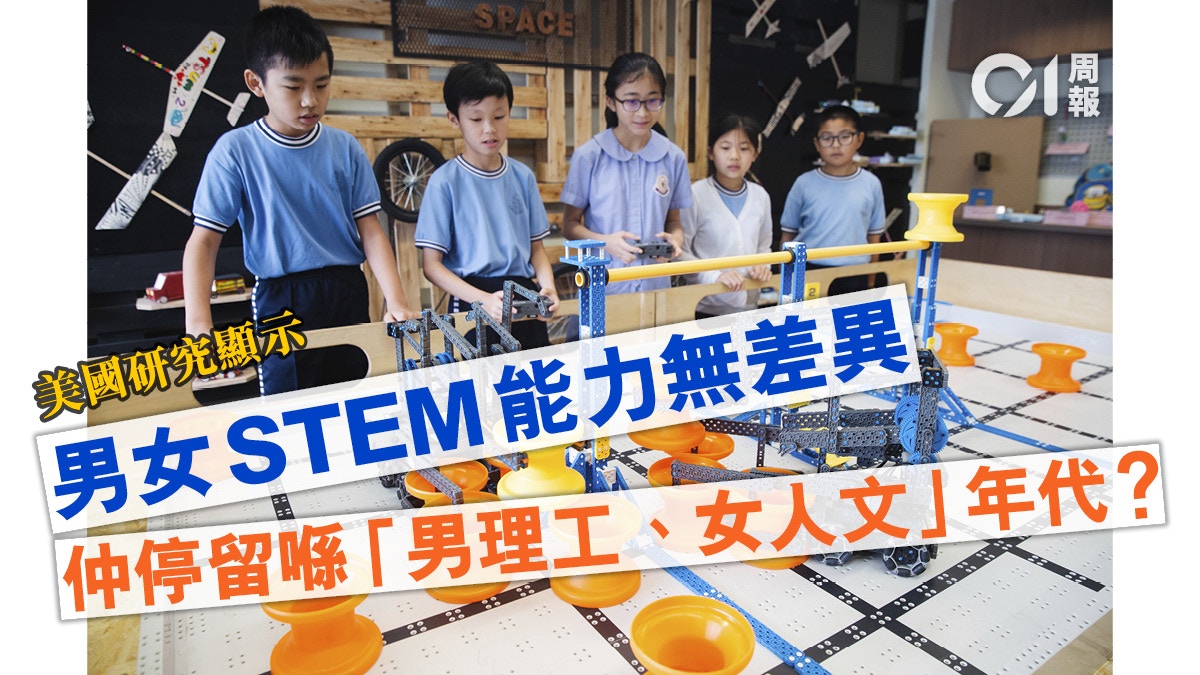weekly
Written by: Jia Wanlin
2020-05-13 17:14
Date of last update: 2020-05-13 17:16In the second decade of the 21st century, society seems to have shaken off the traditional gender stereotypes of "men plowing and weaving women" and become more civilized and more equal between men and women. However, in terms of subject and career choices, there is still a tendency for men to focus on science and engineering and women to choose humanities. STEM * education is more dominated by boys, as if it has become a gender bias of "men plowing women" in the new era.
Hong Kong University of Education professors Su Yongmei and Zhao Yongjia recently wrote in a newspaper article that the University of Education surveyed 39 elementary and secondary schools, about 4,000 high school, junior high school and high school students on Hong Kong students' ambitions for STEM, and found that boys are significantly more interested in technology, science than girls. , Mathematics and engineering work, girls are more interested in medical, scientific work and product design. Two scholars pointed out that there are gender differences in STEM in Hong Kong society, and schools should devote more time to curricula to narrow the gap between boys and girls.
In fact, this is not the first time that research has found that STEM is dominated by men. In 2018, the Hong Kong Women ’s Fund commissioned the University of Education to conduct a survey on “gender differences in STEM-related subjects and career choices among local students. Only 13.9% of students are interested, and only 4.1% are interested in related work, which is more than four times less than 17.5% of boys.
* Note: STEM stands for Science, Technology, Engineering, and Mathematics.
Studies have found that although girls in Hong Kong are more scientifically competent than boys, the proportion of girls who choose STEM-related subjects is lower than that of boys. (Profile picture / Photograph by Zheng Zifeng)
Moreover, patriarchy in the STEM field does not only exist in Hong Kong. The Organization for Economic Cooperation and Development (OECD) pointed out that this is a global phenomenon. For example, in Taiwan, according to the statistics of tertiary institutions of the Ministry of Education in 2016, the proportion of women studying in the natural sciences is 28%, mathematics and statistics are 33%, and engineering is only 13%; in addition, according to the British Higher Education Statistics Office According to the data, only 35% of the students studying STEM subjects in British colleges and universities, of which the proportion of women studying computer science and engineering is less than 20%; the US Bureau of Labor Statistics data in 2019 shows that the STEM field Only 28% of female workers.
Men have more STEM talent?
In STEM-related higher education and work areas, the number of men is far ahead because of the ability of men to have advantages in these fields? The 2018 International Student Competency Assessment Program (PISA) data reflects that Hong Kong girls ’scientific ability is significantly higher than that of boys, with a score gap of 9 points. This is similar to the performance of the male and female students in the Hong Kong Diploma of Secondary Education Examination Statistics for 2019 by the HKEAA. The percentage of girls with a grade 2 or higher in the compulsory part of biology, chemistry, mathematics and physics is higher than that of boys. Research by David Geary, a psychology professor at the University of Missouri in the United States, also shows that there is no significant difference in the performance of men and women in the STEM field, and women generally perform better in other abilities. In other words, there is no research to prove that women are difficult to enter the STEM field because of differences in abilities.
On the other hand, many studies have pointed out that traditional gender education and the derived differences in self-confidence and self-expectation differences between men and women have become a resistance for women to join STEM. Taking the survey conducted by the University of Education as an example, 60% of boys said they would work in technology, but only 30% of girls said they would consider work related to technology. This difference in expectations of the same industry shows that society has cultivated girls with a more docile and caring personality, and it is easy to shape girls ’tendency to engage in jobs that directly and help others.
The Education University survey found that boys in high school, junior high school, and high school have significantly higher self-efficacy in STEM subjects than girls. (Information Picture / Photo by Deng Qianying)
The stereotyped differences in the identification of men and women in science and engineering capabilities have also caused differences in the confidence of men and women in science and technology learning, which in turn affects academic pursuit and self-expectation. The Education University survey found that boys in high school, junior high school, and high school have significantly higher self-efficacy in STEM subjects than girls. In other words, even if the girls ’test results in PISA show that their scientific ability is higher than that of boys, they still have insufficient consciousness. A typical mentality is that many girls who have achieved good results in STEM subjects in middle school think that their good performance depends only on hard work, and boys are naturally born with the relevant talents of "number sense". It is worth noting that this phenomenon does not only exist in Hong Kong. A study by the American Association of University Women (AAUW) further pointed out that when there is no significant difference in the performance of mathematics between the second and third grades of elementary school, the two have a considerable gap in self-efficacy evaluation.
In fact, when traditional beliefs suggest that men are better at science and engineering, parents and schools will also give higher expectations and encouragement to support boys to dig deeper into relevant knowledge. The difference in acquired learning resources brought about by these very different gender expectations has deepened the differences in the scientific capabilities and employment opportunities of men and women in the future.
Helps protect women's economic rights
In the job market, a STEM practitioner can often earn more than a worker in the general field. Therefore, the phenomenon of male monopoly on STEM will also deepen economic gender inequality, and encouraging women to invest in STEM can provide one more channel to protect women's economic rights and independence.
Research from the University of Missouri in the United States shows that there is no significant difference in the performance of men and women in the STEM field. (Information picture / photograph by Ou Jiale)
The article by Jeff Sossamon, a researcher at the University of Missouri in the United States, mentioned that in countries such as Algeria and Turkey where gender equality is lagging behind, women are more likely to participate in STEM. This is because these women have greater economic urgency to choose these areas with higher return on investment in the process of schooling and employment. Therefore, some studies believe that encouraging women to participate in STEM and tapping their potential in this area will help promote gender equality at the economic and career levels.
On the other hand, the World Economic Forum, AAUW, etc. have mentioned that for product development and related industries, women will consider the details and levels that men ignore, so that the industry can develop more comprehensively. Moreover, gender equality in the STEM field also means a breakthrough in gender stereotypes in occupations, so that men who are interested in humanities and occupations are not subject to prejudice and pressure.
Tap female potential to create a new world
In view of this, local governments, multinational institutions, non-profit organizations, etc. are committed to helping women tap the potential of STEM. For example, in 2015, the United Nations decided to designate February 11 each year as "International Women's Science Day" to promote the development of women's science and eliminate gender prejudice. The Taiwan region has responded much to this and has held many scientific experience activities.
Many technology companies have launched training programs for women, giving women the opportunity to break social prejudices and tap their interests and potential. (Profile picture)
The depth and breadth of Western society's research on gender equality in STEM are amazing, not only focusing on the "glass ceiling" problem of female practitioners, but also beginning to analyze the performance of women of different races on STEM, or comparing European countries. The reasons behind the gap in female STEM participation ratios, etc., even if the depiction of STEM workers on the big screen of the movie deepens gender bias, there is also a special study.
In terms of enterprises, many technology companies have launched training programs for women, giving women the opportunity to break social prejudices and tap their own interests and potential in this regard. Technology leader Microsoft has launched the "DigiGirlz at Microsoft" program to provide 15- to 18-year-old female students from all over the world with technology career plans, as well as some summer camps and workshops where relevant knowledge can be learned.
Looking back at Hong Kong, promoting STEM gender equality still relies on sporadic private activities and scattered forces, and lacks a blueprint for co-ordination and planning. One example is the curriculum reform of Pan Guicai, director of the computer science department of Huiji College, which combines information and communication technology (ICT) that was not very interesting to women in the past and visual arts, so that female students can gradually experience the fun of this subject; -The "STEM Expert Cooperation" study found that fifth-grade female students have significantly improved their knowledge and interest in STEM than boys after participating in a STEM learning activity guided by female environmentalists; "Girls Go Tech" (GGT for short) ) The plan allows girls to get in touch with STEM as early as possible, and to understand the related work in advance. On the day of the publication of the research results, a GGT joint school works exhibition was held to show the works of the extension plan, which increased the interest of female students in the field. These have contributed and tried to promote the development of female STEM in Hong Kong, but failed to form a mainstream force.
"STEM Education Multifaceted View" "Teacher Training (Experience)". (Screenshot from Education Bureau movie)
The main reason for this situation is also the lack of government commitment. Although the Education Bureau has included STEM education in the development blueprint, its actions cannot be separated from the dispatch of money, and then the specific reform responsibilities are shifted to schools, families, and enterprises, and there is a lack of specific overall planning.
In fact, an article published by the World Economic Forum mentioned that the equality between men and women in the STEM field of Eastern European countries was due to the large number of Soviet national research programs in the last century, which encouraged women to participate in it and buried the scientific gender equality. seed. This shows that the government's support and role are very important to promote women's participation in the STEM industry.
Therefore, the government can cooperate with enterprises to give women more opportunities to practice and understand STEM. In addition, the government should launch a corresponding subsidy program to provide support to women who are involved in the STEM industry, so that they can get rid of the dilemma of family business. Moreover, in the face of the stereotype of "male science and women, women", the government should strengthen the publicity of social concepts, so that women's development of STEM can be encouraged and supported by family and society. In conclusion, Hong Kong ’s current promotion of women ’s investment in STEM lags far behind other countries and regions. The Hong Kong government should formulate a detailed plan and undertake more specific affairs so that innovation and development and women ’s equality can achieve a win-win situation in Hong Kong.
related articles︰
【STEM Education】 Whether primary and secondary schools encounter difficulties in the same way, can they spend a lot of money to run the science and technology education?
[STEM Education] Abandoning the test-oriented culture is not a matter of day and night
[STEM Education] Students' ability to innovate in science and technology is going backwards. Is Hong Kong education going the wrong way?
[Classroom renovation. Three] Study tables and chairs flexibly arrange students to move freely in the experiment
The above is published in the 213th issue of "Hong Kong 01" Weekly News (May 11, 2020) "New Age" Male Grows Women "-Gender Differences in STEM Education".
More weekly articles:【01 Weekly News Page】
The "Hong Kong 01" weekly newspaper is available at major newsstands, OK convenience stores and Vango convenience stores. You can also subscribe to the weekly report here to read more in-depth reports.
STEM Gender Discrimination Gender Issue Gender Controversy 01 Weekly Report


/cloudfront-eu-central-1.images.arcpublishing.com/prisa/Q6UJ4IEP6ZGLZLS3MSHF7LNYOU.jpg)



/cloudfront-eu-central-1.images.arcpublishing.com/prisa/NYBERFPPHVEJVER4FIRIEAGGX4.jpg)

